PART TWO - THE SOFTWARE YEARS
Sometime in 2001 or so I recalled seeing BT in an Apple promo video gushing about how you can make a record with nothing but a laptop, and on his screen was the program Propellerheads ReBirth. I was not too impressed, as I had seen ads for ReBirth in music rags, and software versions of Roland's TR808, TR909 and TB303 may have been a techno-heads dream, but I was in an anti-dance music state back then (too much King Crimson I guess).
Well, by 2002 my pal Soren hipped me to this thing called Reason (also by Propellerheads). I thought, 'yeah, yeah, another friggin' dance-music novelty'. But since it was one of the few music apps available for Mac OSX, I downloaded the demo of Reason2 in late 2001. I was quite impressed at the breadth of stuff it could do, and with that the days of hardware synths began a rapid decline as my means of composing music...
PROPELLERHEADS REASON

Much to my surprise, I was quite impressed with the demo song that came with demo of Reason2 I downloaded and in early 2002 I purchased my first software instrument. Reason demonstrated to me that this software was more than a machine for disco ditties (though it excels at that). It was pretty intuitive to use, but it was worth the money to invest in a training CD. Reason is sold as a 'do it all in one program' package, and it does as advertised, as long as you don't want to add your own vocals or other live instruments (sure, you can import samples of your stuff, but it's not the same). What makes Reason hella-kewl is the fact that all of the instruments are modular, and can effect each other in a million ways.
Basically, Reason gives you synthesizers, samplers, drum machines, rhythm sequencers, effects and other swell stuff. You can stack as many instruments and effects as your PC's processor can drive (and I have yet to exceed the processor on my old Powerbook). The biggest effect Reason had on me was to finally (after 25 years of resistance) get me into using samplers. I had always view samplers as novelty instruments, and considered myself a synth-purist. But with Reason's great user interface, making sample patches is easy. The synths that come with Reason are good too, but I still prefer playing with virtual versions of old synths, despite the fact that Reason's synths have more routing flexibility.
APPLE GARAGEBAND
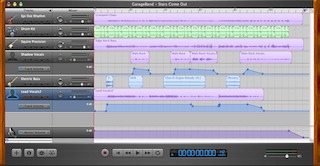
When Apple added Garageband to it's iLife suite of consumer apps in 2004, it didn't seem like the kind of app that I would use, as it didn't seem "pro" enough (but the truth be told, I had failed to use pro apps like MOTU Digital Performer for years). Now I am an unashamed Garageband fan, and it's my primary method for composing songs of all sorts. Whereas Reason's orientation was dance styles and sounds, Garageband had a very impressive set of 'bread'n'butter' sounds that were more suited to my song-writing style. Since the stock sounds were so good, I bought all of the 'Jam Pack' add-ons and began to fill my drive space like it was going out of fashion.
Above it all, Garageband's user interface is free of the clutter and excess of most music apps, and is perfect for all kinds of tunes. It has a good range of effects, loops and even better, it supports AU (audio-unit) plug-ins, so I host all of my virtual instruments in this as well. Speaking of which...
ARTURIA CS-80V
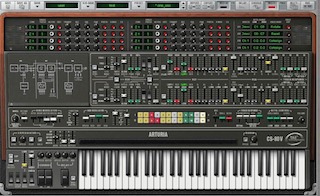
If you have followed the history of synthesizers, you'd know that the Yamaha CS-80 occupies the same place in the hall of sought-after behemoth keyboards as the Elka Synthex, Oberheim Matrix-12, Roland Jupiter-8, etc. The CS-80 was a monster synth, huge in size, weight and sound. Originally a pro-only synth, as it ran about $7000 new. But it was famous for it's warm (with a capital W) sound, legendary for pads, brass & string stuff. When I found out that Arturia had made a virtual version I downloaded the demo pronto, as I had never played one, only knew of its reputation. I was so smitten with the sounds, that I bought it soon after. So in early 2004 I began my obsession with virtual synthesizers.
I grew up in the days of synth-gods like Wakeman, Emmo and especially Geoff Downes, who gained notoriety in the 80s by dragging over 20 synthesizers on stage. So I suppose I've always liked the idea myself, and with virtual synths, I can have all that egomania in the space of a laptop. The CS-80V has a great sound, a wide range of patches and some extra stuff (like effects) that were not in the original. Big phasey brass is the leitmotif of this virtual, and power comes at a cost - your processor - this thing eats CPU cycles with no mercy. But it sounds so rich that I rarely need to layer sounds.
NATIVE INSTRUMENTS FM-7 & FM-8
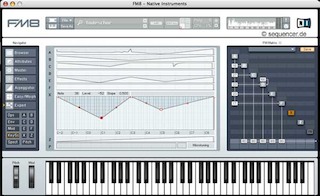
Probably the most famous synthesizer of all time is the Yamaha DX-7. If you read the previous section of Synthistory, you'll know that I had whole series of FM synthesizers in my quiver. I never owned a DX-7, and had long assumed that it was the holy-grail of synthesizers as I forced to mke do with my low-cost Yamahas. If only I'd known then that the difference was small and not worth the time spent dreaming that one day I'd own one.
The FM-7 instrument takes the DX-7 architecture and adds on to it, making it a more sublime instrument that has increased flexibility and a much wider range of sounds. You can create any algorithm you want, instead of the fixed ones on the DX series, and with filters, effects and other fun stuff, it's the DX that I was really hoping for way back in the 80s. So if whenever I gotta have that glassy, metallic sheen on my sonic shite, this is where go. A very nice feature is that it can import sys-ex data from just about any FM synthesizer, and with the literally thousands of FM free patches on the web, you are a pig in FM slop.
I upgraded to the FM-8 as the FM-7 was not Intel-Mac compatible.
SPECTRASONICS ATMOSPHERE
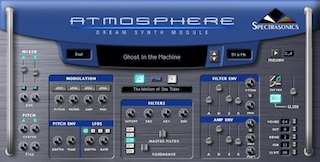
Once the li'l virtual synths had made a dent in the market, enter the next wave, the ROMpler, virtual instruments that were purchased for their library of sampled sounds rather than an ability emulate a wheezy ol' keyboard. Most of the early Romplers didn't peak my interest, but after hearing some of the sounds this thing could make, i purchased Atmosphere in short order. It's a simplification to say that Atmosphere is just for pads, but that's mostly true, they've added some string and synthesizer sounds, but I mostly just use this for the ethereal tones. The biggest liability is not being able edit or mix the effects, you get what you get. But layer two or three 1-note Atmosphere patches, and you've got instant ambient stuff ready for the chillout rooms of the world. One thing Spectrasonics are masters at is doing a good user interface, most Romplers look they're designed to be used in the Soviet armed forces, institutional and drab, but Spectrasonics does a great job at good looks and ergonomics. Best of all, Atmosphere sounds fantastic, just hold down a chord and float away...
NATIVE INSTRUMENTS PRO-53
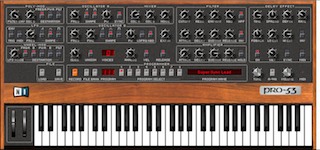
I know this will sound doofy, the first time I became aware of the Sequential Circuits Prophet V synth was in a magaizine article on the (ulp) Thompson Twins (which I'm ashamed to say I was rather smitten with back in their heyday). There they were surrounded by Prophet5s and I still associate that sound with those teeny boppers. Of course the Prophet5 was the first polyphonic synthesizer to make it in a big way, as it sounded quite good and allowed you to save your patch settings (a real novelty back in the 70s). It was standard equipment for any 80s synthpop combo, and reached its zenith with the whacky Japan song "Ghost".
Unfortunately Native Instruments didn't give it the same treatment that they gave the DX-7, so aside from a few minor extras, it's just virtual Prophet, and that's no bad thing. Unlike the CS80V, it doesn't murder your processor after two layers, and it's fun to build thick Prophetscapes. It's too bad they didn't take it to the next level and base it on a Prophet 10, with layering, but you can get that via your sequencer, so it's not too bad. I'm sure purists will disagree, but it sounds close enough for my needs.
ARTURNIA MINIMOOG-V
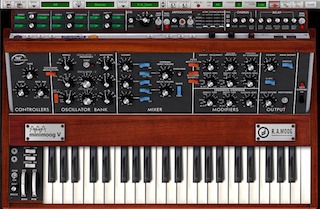
For so many years this is what people thought of when you said 'synthesizer'. I was lucky enough to play a Minimoog when i was about 11 years old, as my Uncle John owned a music shop and brought one to his home in 1973 to show off to us. Maybe that more than anything cast the die for my interest in synths. My fighter-pilot father was fascinated with it, doing imitation jet-engine afterburner sounds. Well things came full circle after I installed this virtual version on my laptop and showed it off to him, afterburner sounds intact.
This was purchased at the same time I got the Pro-53, which is kind of novel as i can remember seeing many keyboardists armed with the same setup, the Prophet for poly sounds, the Moog for lead stuff. Whereas the interface of the Pro-53 small and static (though faithful to the original) the MinimoogV is large and lavish, with some nice add-ons. Like it's brother the CS-80V, it is a hog on your processor, but the sounds are worth it. Good enough in fact to earn the seal of approval of Robert Moog himself (we miss you Bob!!!). Arturia has provided some nice add-ons, like polyphony - which means you can tap into sounds ala the behemoth Memorymoog. They've also added a nice, though modest, effects section. And better still, a swell arpeggiator thrown into the bargain. For me it will be the last word in synth-bass sounds.
SPECTRASONICS TRILOGY
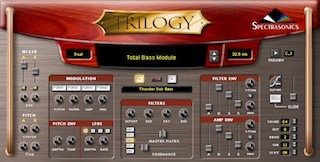
As I'm a longtime bass player, with a fair stack of bass sounds of all kinds, I didn't really need this Rompler, but I was so smitten with Spectrasonics' Atmosphere, that I just figured that this would be a good buy. Indeed Spectrasonics came up with a clever idea called "True Staccato" which maps different bass parts on a keyboard, making for more realistic playing. It excels at synth-bass, with a wide range of tones, but the electric bases come up short. The pick and finger basses are not great sounding, and there's not enough variety of them. Though it offers the same synthesis possibilities that Atmosphere does, I don't have the need to mess around with the sounds of basses (and I'd rather do that on my virtual Minimoog). This is not a bad sound module at all, but I think it should have been focused on a wider variety of electric bass sounds or just a selection of synth bass tones.
SPECTRASONICS STYLUS/STYLUS RMX
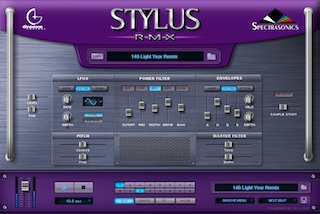
I purchased the original Spectrasonics Stylus program for the same reason I got Spectrasonics Trilogy, because I liked Atmosphere so much, and thought that Stylus would be the rhythms what Atmosphere was to pads. Boy was I wrong. I found Stylus hard to use, lacking in usable features and basically a box of redundant breakbeats. But I was swayed by hype surrounding the second coming of the product, called Stylus RMX. Stylus and Stylus RMX are both purple, but other than that, they are different beasts. Every weak feature of Stylus has been beefed up and then some in Stylus RMX. The depth of features of RMX is staggering, with a wide assortment of ways to modify and mutilate your beats.
To me the most exciting feature is called Chaos, which allows you to add entropy in various ways. But what makes this so swell is that you can control the musicality of the chaos, and so it can have a more natural feel to the variations in tempo, pitch, fills, etc. The fact that you can separate elements out of a beat (like the hi-hats just the snare) and only effect them is really keen. Then add extensive effects (all independently programmable), REX imports and other swell stuff, and this is a module that you can waste acres of time with. The stock beats are very much geared toward dance, hiphop and like music. However, you can get expander modules that may be more to your taste, and you can import your own REX sounds. This is the most groovy rhythm machine I've ever used.
KORG LEGACY COLLECTION - DIGITAL & ANALOG EDITIONS
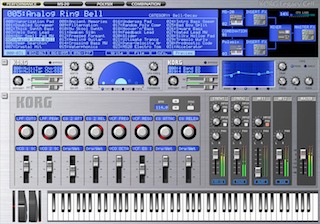
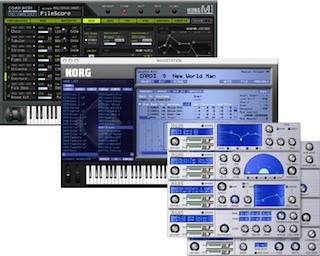
There was an earlier Legacy Collection, but all I wanted was the virtual Wavestation and didn't want the rest of the stuff. Thankfully they created an alternate version with a virtual M1 and Wavestation. Better still they include all the expansion cards and libraries that were issued with the hardware. It's OK to have the M1, but I really wanted the Wavestation, as I missed those unique pads (and even Atmosphere couldn't make up for Wavestation sounds.) Korg as made some good changes, like adding resonant filters to the Wavestation. I don't use the effects unit.
Then Korg came out with what I had been hoping for, a virtual Mono/Poly, now part of their expanded Korg Analog Collection. That way I had several of the synthesizers I had owned in hardware form as software instruments. I love the Mono/Poly, with all of the character of the original (of course it's not exactly the same!) and lots more stuff besides
ABLETON LIVE / OPERATOR
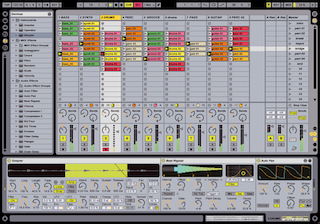
For years I had been trying to ignore Ableton's Live. Partially this is because Live did not initially support plug-ins or external MIDI instruments. I wound up getting this via a convoluted route. I have become a big fan of Monolake's music and when I saw some demos of Robert Henke (AKA Monolake) using Live, and was impressed the effects and sounds. Soon after I wound up with a Live Lite via a bundle with my Korg Kontrol, and liked it so much that I upgraded to the full version. It's different than other audio/midi studios I've used, but once you get used to it's approach, it does work well. What I like it Ableton's untraditional approach to audio and midi effects, which makes for more novel sounds.
For an extra hundred bucks you can get Operator, which is a simplified FM synthesizer, which has some unusual twists that the FM7 doesn't, and so i got that add-on as well.
APPLE LOGIC8
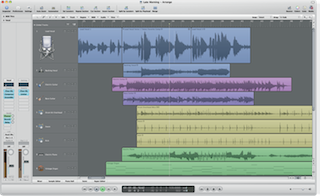
I mainly used Garageband for song-writing and hosting virtual instruments. But I decided to upgrade to Logic Express 7 as I wanted some more advanced features. I would up liking Logic Express so much I bought Logic Pro 7 a few weeks later. I used that for the instruments and effects, importing my Garageband sessions when i wanted them. When Apple announced Logic Studio 8, I leapt at it as you could finally ditch the dongle and it was a better interface. I use this more and more, starting projects in Logic 8 instead of Garageband.
